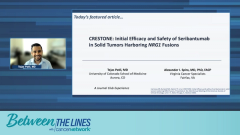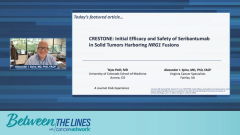
CRESTONE Trial of Seribantumab in Solid Tumors With NRG1 Fusions: Efficacy Data
Shared insight on key efficacy data from the CRESTONE clinical trial of seribantumab therapy in solid tumors with NRG1 fusions.
Episodes in this series

Transcript:
Tejas Patil, MD: This is the clinical activity of seribantumab in tumors harboring NRG1 fusions. These are small numbers, so I think we have to take a lot of what we look at with a grain of salt, but the objective response rate in the primary efficacy population, which is cohort 1, was 33%, with 2 patients receiving complete response, 2 patients receiving a partial response, many patients had stable disease and 1 patient did have progressive disease. The disease control rate, shown here, is 92%. In cohort 1 when we just look at the non–small cell lung cancer population we are finding very similar response rates, which makes sense given that if this is a truly gene fusion-driven cancer, then it should in theory respond regardless of other factors. So the response rates that we are seeing here [are] 36% objective response rate and then 18% complete response rate, 18% partial response rate. I’m going to put all of this with the caveat that these are all very small numbers. We are looking at an N (sample size) of 12 and an N of 11, and I think as more patients enroll in this study, and if it gets FDA approval and you look at the real world data, I think that’s where some of this will play out in kind of interesting ways. What are your thoughts on this Dr Spira?
Alexander I. Spira, MD, PhD, FACP: I start by looking at the disease control rate, which is pretty good. It’s in the 90% range, which is obviously what I would like to see. I think what I would like to see is, number 1, when I think about [it] from a tumor-agnostic standpoint, 11 lung and 12 totals, so we have a lung-predominant population, and that’s still fine. We know it exists in other tumor types. I already know there is going to be some immediate criticism as we experience other mutations such as KRAS and Exon20. The objective response rate is only a third of patients, right? The N is very small here, so 1 additional patient would have increased the response rate by 7%. I think [results] will have to wait to be seen, but if it holds out in this 30% to 35% range I think it will be not as good as we were hoping for, but still very good when you consider that there are no alternatives.
Tejas Patil, MD: Right.
Alexander I. Spira, MD, PhD, FACP: I was very surprised when sotorasib was first approved for non–small cell lung cancer in the second line; immediately everyone said the response rate is only 40%, this stinks. Well, take if for what it is worth, there is nothing else competing against it; your standard of care for this is docetaxel in the second-line setting. So I think taking that with a grain of salt, but we are seeing clear activity here, especially in a very heavily pretreated population.
Tejas Patil, MD: I had similar thoughts here when I was looking at this data, which is: what is the comparator in this line? All these patients receive 1 line of systemic therapy, so the comparator would really be something like docetaxel, which does have FDA approval, and we know the objective response rate for that is really poor. In non–small cell lung cancer, the bar is low. Interestingly, like you pointed out, we really need to see what the data look like, because in pancreas cancer the objective response rate for second-line pancreatic regimens is really low. So having even a 33% to 36% response rate is interesting. One thing I would like to see as the data mature, it will be really interesting to look at the median duration response, and we will probably cover that in a subsequent slide. But I do want to flag that as a very interesting end point, because are the responders really responding? And then the question [becomes], what is going on with the non-responders and what do we need to optimize?
This is the waterfall plot looking at the efficacy of seribantumab in harboring NRG1 fusions. As you can see here, there were 2 patients with complete response rates and then several partial responses, but the majority had stable disease with some tumor reduction from the baseline. Any thoughts here Dr Spira?
Alexander I. Spira, MD, PhD, FACP: I think this is what you want to see. When you look at the first slide, the response rate is not as good as we would like, but 11 out of 12 patients are on the downward side here. So this is telling me that it is working. Again, I think that it is a very heavily pretreated population. Lung cancer is one of those cancers where I know you probably do this as well as I, you look at the CT scan and [ask] how much is lung and how much is tumor? You either have atelectasis, obstructed lung, we don’t have a lot of [INAUDIBLE] which is usually easier to measure, especially as the patients have progressed. For me this is great. When you look at a 33% investigator assessed overall response rate, we are going to want central review to really show improvement number one. But once you get to that one-third level, it starts to begin the question is this really going to be approved based upon this data or are you going to have to do a randomized confirmatory study vs a comparator. I’m not the FDA, but I think when you have a biomarker we are wanting to see something better than the standard of care, the standard of care is docetaxel. Docetaxel, I tell people, is a drug that I don’t think would be approved right now based upon its efficacy. It was approved probably before your time and I actually barely remember it, it was a tough drug. I think when I see the waterfall plot I’m a little bit more impressed.
Tejas Patil, MD: Good points. This is the efficacy of seribantumab in tumors harboring NRG1 fusions regardless of fusion partner. What is color coded here are the different fusion partner subtypes. My thoughts are just preliminary here. When the data are this small, it is really hard to make any conclusions as to whether CD74 has any differences vs other fusion partner. They have looked at this in other gene fusions, in ALK, ROS1, RET, to look at CD74 vs non-CD74. These are common fusion partners for those genes, and the data that I have seen so far really do not clearly show that one is driving a poorer response than the others. I think part of the reason is that we just have a very hydrogenous set of fusion partners, and these are the ones that are most commonly identified. Although my sense is as we start to do more RNA-based NGS [next-generation sequencing] testing, we are probably going to find novel fusion partners and go from there.
Alexander I. Spira, MD, PhD, FACP: My only thoughts here are [that] at the end of the day I don’t think you are ever going to get data about is 1 fusion partner different than another. The study has been going on long [enough] for you to find just these 12 patients and you already have 5 fusion partners identified. So are you ever going to get really enough of an edge to get a difference? I think it just reminds me that you have to be doing RNA sequencing techniques to figure this out.
Tejas Patil, MD: It’s interesting. In the lung space a lot of academic centers and even community centers have been doing NGS-based testing, so emphasizing RNA-based NGS1. I think a lot of companies are moving in that direction. But this also emphasizes to me that I think for other solid tumor types, the pancreas, for example, is a very common gene fusion of KRAS wild type. They’re going for a tumor-agnostic indication for a tumor that has an incidence of less than a percent. This is going to be one of those tradeoffs between tissue and testing. How hard do you look for something that’s this rare? These are important questions we’ll talk about as we go through the slides.
Transcript edited for clarity.
Newsletter
Stay up to date on recent advances in the multidisciplinary approach to cancer.









